A Mix of Technology and Trivia on Ordinals, Inscriptions, BRC-20s, and Other Interesting Things
Article by Tigi76 | Edited by Hiro Kennelly and Trewkat | Cover Art by Tonytad
You will not find a more trendy topic in crypto today than Ordinals and BRC-20 tokens. In just a few short months, an incredible number of Inscriptions have been made (check out this list of total Inscriptions to date). During this time new acronyms proliferated, such as BRC-20, ORC-20, and SRC-20, and we saw the emergence of DeFi products forked from Balancer for the Bitcoin network. We have seen influencers flourish, communities, marketplaces and tools of all kinds develop, and many of crypto’s most prominent analysts and researchers are paying attention.
Please note: I will not analyze the performance of any token on the Bitcoin blockchain and try to stay away from talking about the financial aspects of this crazy world of Bitcoin.
I’ll focus on some interesting but also strange (and even funny) details about the Bitcoin blockchain, a few of the newer protocols that are emerging alongside Inscriptions and BRC-20s, and hint at the new trends.
Of course, remember… This is not financial advice. DYOR
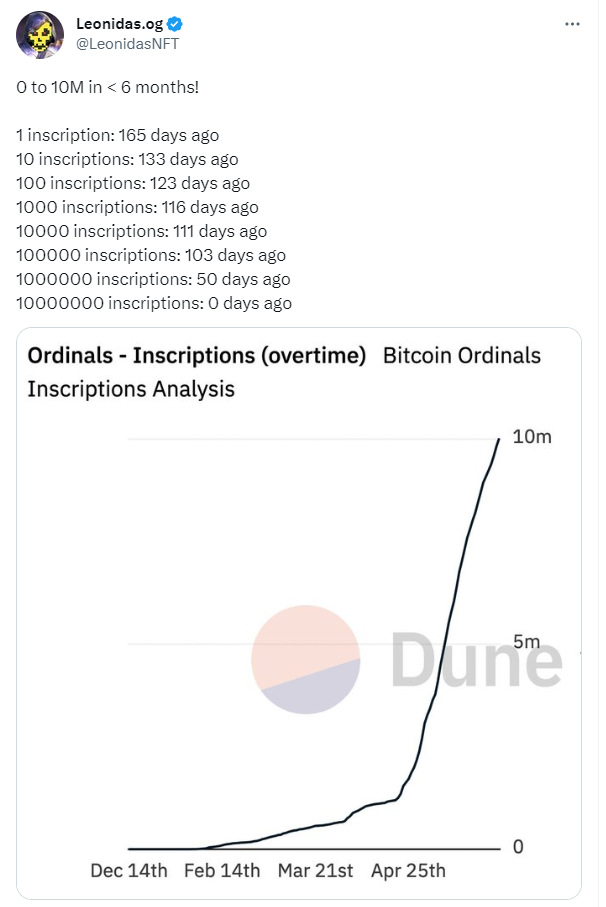
Ordinals and Inscriptions
Let’s start with the origins. Contrary to what you may think, using the Bitcoin blockchain for more than just peer-to-peer payments goes back further than December 2022 when, for the first time, Ordinals were mentioned.
As always, Bitcoin was ahead of its time.
In 2012, the Colored Coins project aimed to attach real-world assets to Bitcoin’s UTXO set. In 2014, the first NFT was released on the Bitcoin blockchain. Its name was Quantum, a generative art piece created by Jennifer and Kevin McCoy. In 2017, Rare Pepes was released — if you have ever wondered, as I have, why these green frogs are so famous you can read the story of Pepe the Frog, study the Rare Pepe Directory, and check out this Bankless article.
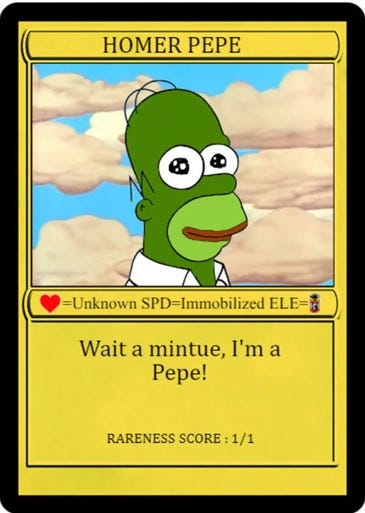
Rare Pepes was made possible using a Bitcoin sidechain named Counterparty. The sidechain is live and hosts a number of projects. Apart from these, Stacks is another sidechain project that deserves mention; Stacks uses Clarity language for smart contracts and has its own chain, compiler, and coding language. It runs in sync with Bitcoin to ensure transaction integrity.
Anyway, after this historical detour, let’s return closer to the present.
In December 2022, Bitcoin developer Casey Rodarmor released open-source ORD Software, which runs on top of a full Bitcoin Core node and allows users to encode computer files into hexadecimal data within a Bitcoin transaction. Thus was born the Rodarmor Theory. The core principle — some would say insight — of the Rodarmor Theory is that it is possible to order satoshis chronologically based upon when they were mined.
For background: A satoshi is the smallest unit of account on the Bitcoin network, and each bitcoin contains 100 million satoshi (colloquially known as �?sats’). After all bitcoin are mined in 2140, there will be 21 million bitcoin in circulation, so the total number of sats in circulation will be 21 million (bitcoin) x 100 million (satoshis) which according to a comment on this Reddit post is “2.1 quadrillion”.
With Rodarmor Theory, it is possible to see in what order each satoshi was mined and assign to each a different degree of rarity depending on the year in which it was mined or its position relative to a particular event such as a fork or sharding. Hence the name Ordinals.
Furthermore, according to Rodarmor Theory, it is possible to inscribe data on each satoshi. Hence the name Inscriptions.
Classifying Ordinals According to Rodarmor’s Theory
According to Casey Rodarmor�?s blog, “Inscriptions are digital artifacts native to the Bitcoin blockchain. They are created by inscribing sats with content using ORD, and can be viewed with the ordinals explorer. They do not require a separate token, a side chain, or changing Bitcoin”.
Casey Rodarmor proposed a classification of satoshi clarifying that “Bitcoin has periodic events, some frequent, some more uncommon, and these naturally lend themselves to a system of rarity”. He first listed the relevant events that could affect the rarity classification:
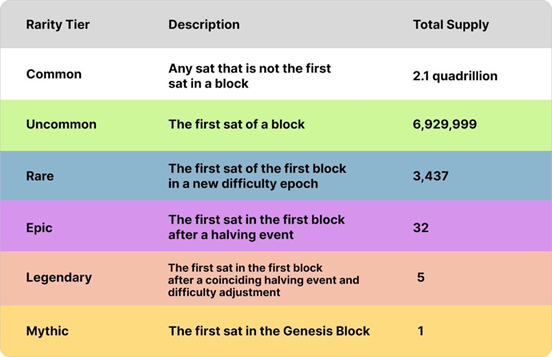
On the Ord.io website you will find an interesting alternative categorization (Satributes) that allows you to view the Inscriptions issued according to the category they belong to. Each Satribute helps to tell a story of where these sats have been.
Based on the above, Rodarmor identified the following categories:
- Blocks: A new block is mined approximately every 10 minutes, from now until the end of time.
- Difficulty adjustments: Every 2,016 blocks, or approximately every two weeks, the Bitcoin network responds to changes in hashrate by adjusting the difficulty target which blocks must meet in order to be accepted.
- Halvings: Every 210,000 blocks, or roughly every four years, the amount of new sats created in every block is cut in half.
- Cycles: Every six halvings, something magical happens: the halving and the difficulty adjustment coincide. This is called a conjunction, and the time period between conjunctions a cycle. A conjunction occurs roughly every 24 years. The first conjunction should happen some time in 2032.
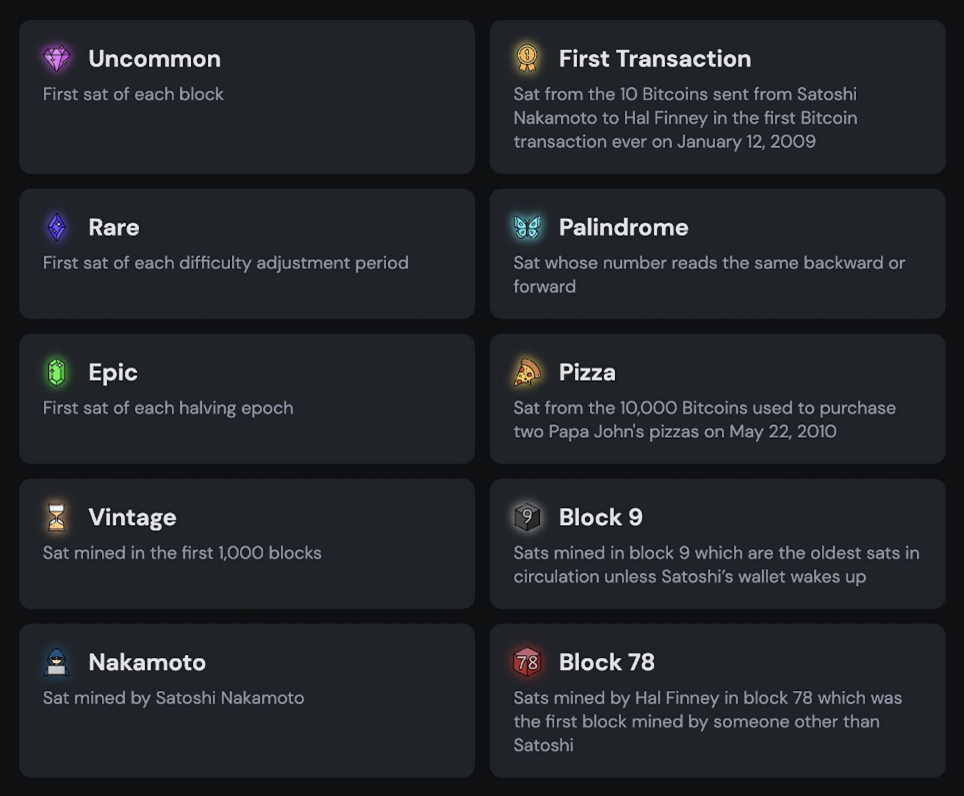
Main Collections and Other Amenities
You might discover a lot of interesting and fun things by scrolling through the Inscriptions catalogs. All of these things will remain inscribed in perpetuity on the Bitcoin blockchain.
The first Bitcoin Ordinal ever created is pixel art of a skull, inscribed in December 2022 by Rodarmore. Check out this list of the first Inscriptions ever — the first twelve of which are below!
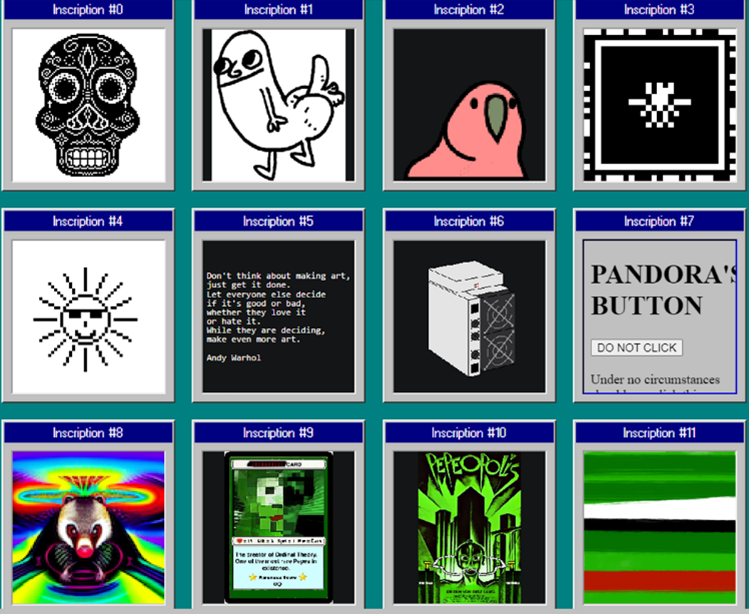
There are real collections. Some others, each with a total supply of 10k, are:
- Bitcoin Punks, playing off the famous CryptoPunks NFT collection.
- Bitcoin Frogs
- DogePunksBTC, an Italian project.
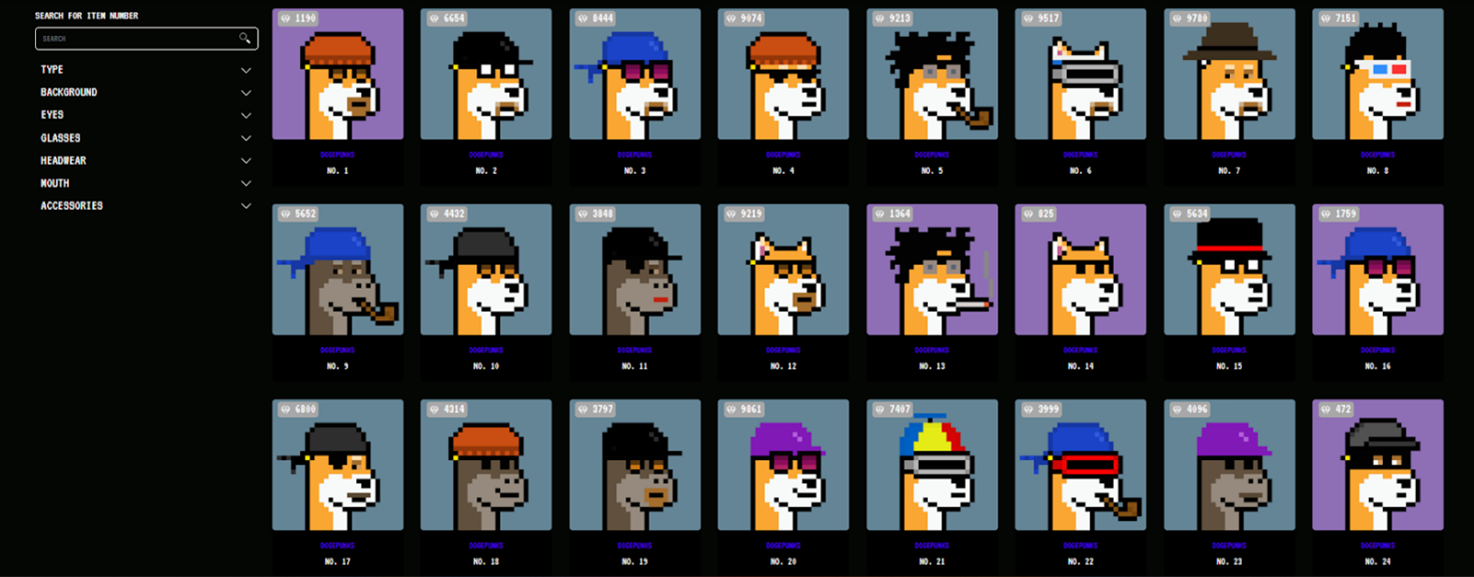
Here are some of the most distinctive Inscriptions:
- Inscription 1,015 is a playable game, known as Frogger.
- Inscription 1,049 is a well-known playable version of Breakout.

- Inscription 1,134 is a picture of Laszlo Hanyecz, who paid 10,000 BTC for two Papa Johns pizzas.
- Inscription 203,408 contains a 3D object.
- Inscription 649,842 by OrdinalCars is a playable game.
- Inscription 900,705 is a playable RPG game.
- Inscription 1,094,462 is the Cypherpunk’s Manifesto published by Eric Hughes.
- Inscription 1,100,043 is a playable version of Tetris.
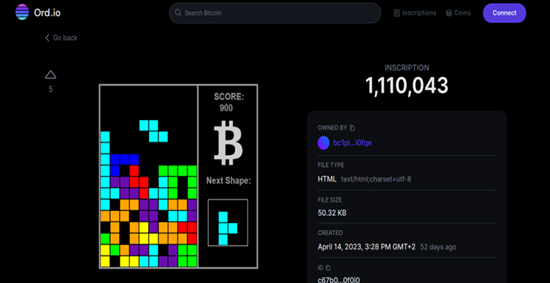
- Inscription 1,126,921 is another playable version of Brick Breaker.
- Inscription 1,160,071 is a playable version of Asteroids.
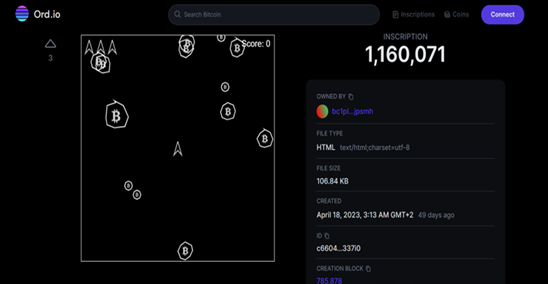
- Inscription 7,345,219 is a playable version of Space shooter.
- Inscription 8,669,069 is on the first sat of a difficulty adjustment period: a rare Ordinal.
- Inscription 9,235,048 is the first-ever inscription on a sat from block 9, and the first on a sat mined by Satoshi and sent to Hal Finney in the first Bitcoin transaction ever! By the way, also on block 9 you will find OrdinalMaxiBiz by ZK_shark.
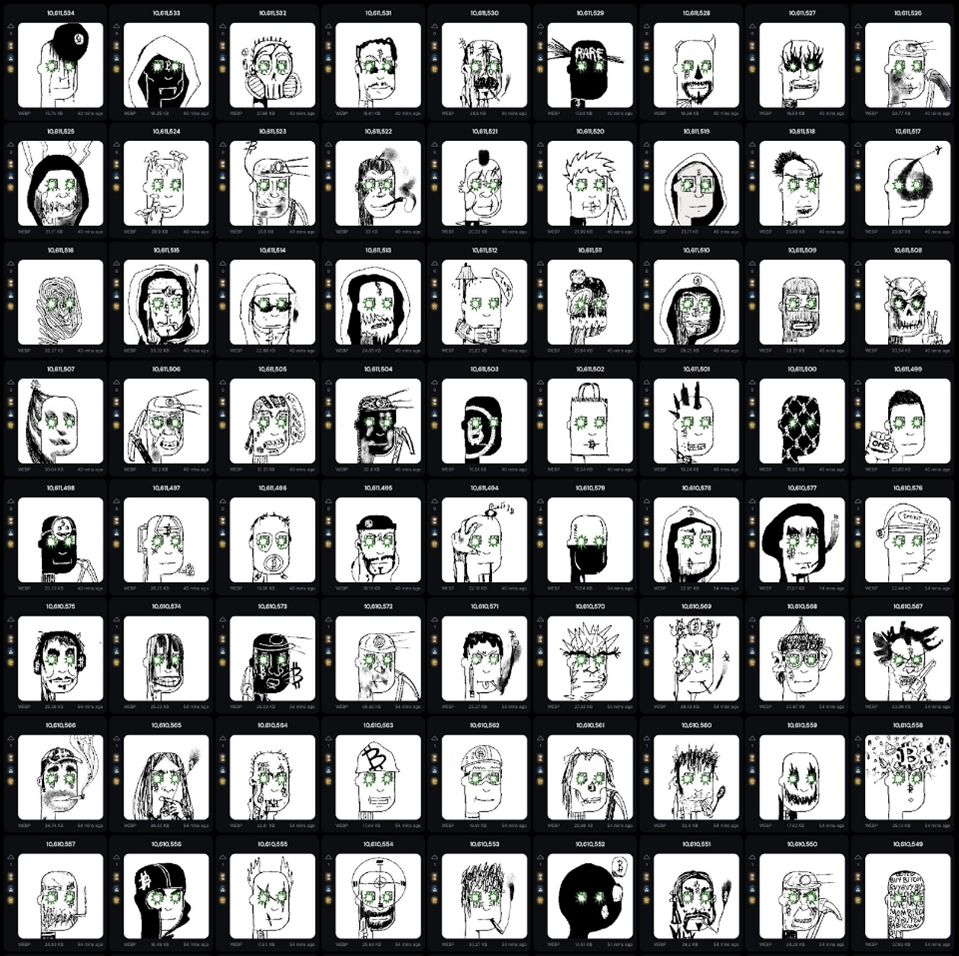
Great videos are also stored on the Bitcoin blockchain, including a famous lecture by SEC Head Gary Gensler at n. 1,933,775, six seconds of Binance’s CZ at n. 1,164,382, and of course the Rickroll at n. 147,156.
On February 2, 2023, the largest block (4MB) and the largest transaction in Bitcoin’s history was mined, containing 5,896 Inscriptions.

Here’s another strange thing: Ordinals that did NOT receive an inscription due to a bug in the protocol and which are currently not recognized by indexers are called “Cursed Inscriptions”. There are over 3,600 Cursed Inscriptions recognised by a negative value, counting back from 0!
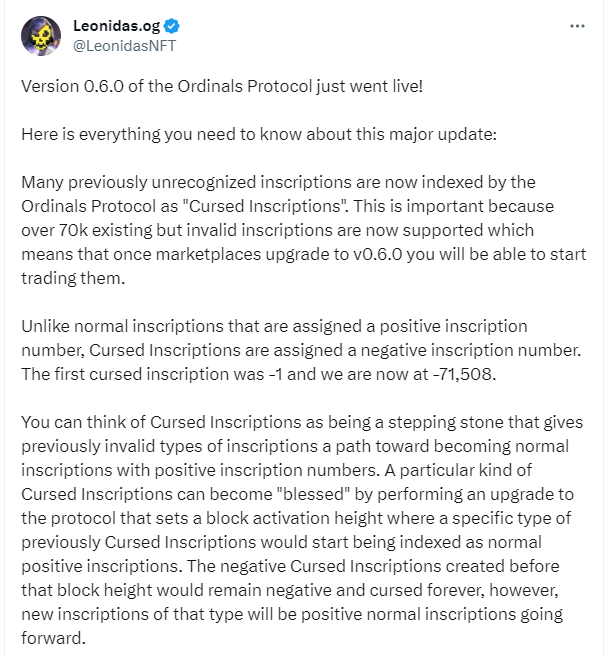
You will find many other interesting things by following Ord.io and @leonidas.og, including 5 Things Every Ordinals Collector Should Know. Ord.io uses AI computer vision to scan Inscriptions and give them tags. For example, you can search for “dog” and see all of the Inscriptions with a dog in them!
Finally, as you can see from the Dune graphic below, the vast majority of Inscriptions are text. The prevalence of text over images is because of the BRC-20 standard.
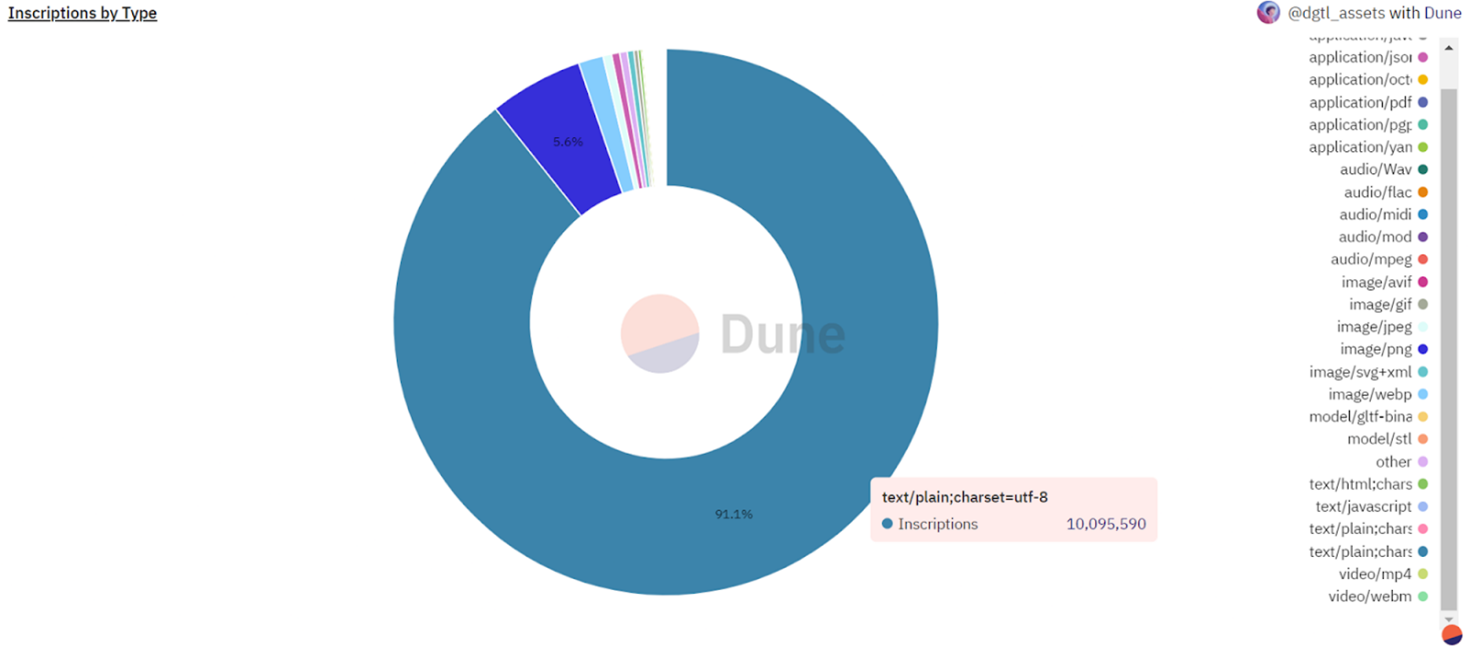
Before you read on, be sure to check out the generative art on Generative.
For loves of data and analysis, below are some interesting dashboards on Dune:
- Bitcoin Ordinals Analysis
You will find info about Ordinals and Inscriptions, Ordinals fees paid, Ordinals and Inscriptions by type, and per block Inscriptions. - Ordinals Marketplace
You will find info about volume by marketplace, transactions by marketplace, percentage share of volume by marketplace, and percentage share of transactions by marketplace.
How Can You �?Immortalize’ Your Favorite Photo as an Ordinal?
From a practical point of view, using an Ordinal client like unisat.io is really simple. The problem is the fees, increased due to the high number of transactions on the Bitcoin blockchain caused by the novelty of BRC-20 tokens, which we will discuss below. As with Ethereum, some believe a good solution to the problem of high fees and network congestion is ZK rollups.
Tip: If you would like to immortalize images or videos as an Ordinal, remember that the maximum block capacity is 4MB. For this reason there are various tools that allow you to reduce the size of the files to be inscribed.
While Ordinals have brought non-fungibility (the NF in NFT) to the Bitcoin blockchain by creating immutable digital artifacts, the BRC-20 standard gives fungibility to Ordinals and Inscriptions in the form of token transfers.
For a general overview of Ordinals and Inscriptions, including controversies between Bitcoin maximalists and proponents of a renewal of this protocol, including the importance of SegWit and Taproot updates, it is possible to find more details in three different, comprehensive studies by Galaxy, Glassnode and Grayscale.
The Antagonist of Inscriptions: STAMPS (SRC-20)
STAMPS (Secure Tradeable Art Maintained Securely) protocol (also known as SRC-20) proposes an alternative method for embedding image data (mostly) on the blockchain, with different tradeoffs than the Inscriptions technology.
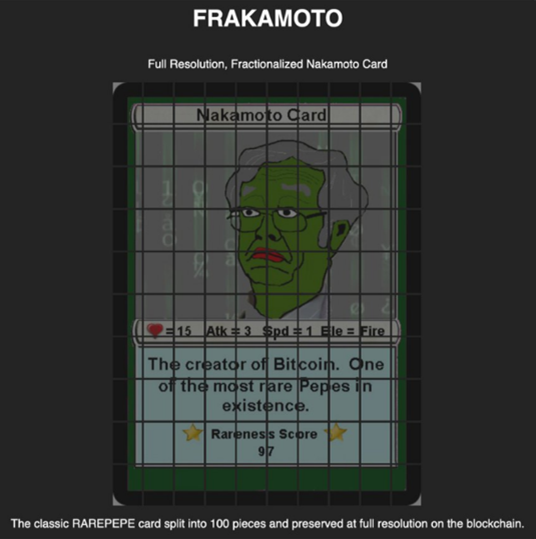
Instead of storing image data within the transaction Witness Data, Stamps stores it directly within the results of spendable transactions. Basically Stamps splits up an image into a bunch of tiny pieces, spreads it across many UTXOs, and reconstructs them on the other end.
“By doing so, the data is stored in such a way that it is impossible to delete from a complete node, preserving the data immutably forever,” wrote Stamps creator Mike In Space on the project’s GitHub page.
From the very beginning, Ordinals fans said Inscriptions were superior to NFTs because their data is stored within the Bitcoin blockchain itself, rather than the standard practice of the blockchain data consisting of code used to retrieve the image from centralized hosting services, which can be modified by anyone in control of the image URL.
Even with Ordinals, however, the immutability and decentralization are limited because Ordinal data can be arbitrarily pruned by individual node runners who decide to download only part of the blockchain. This is the main justification behind Stamps, which goes above and beyond by requiring nodes to store image data in a variety of UTXOs.
Creating a Bitcoin Stamp is relatively easy. Your favorite image must first be converted into text, more specifically Base64 text. Using the Counterparty protocol, which divides the text into multiple parts, users would take this encoded text, add the word “STAMP:” in front of it, and broadcast it to the Bitcoin network.
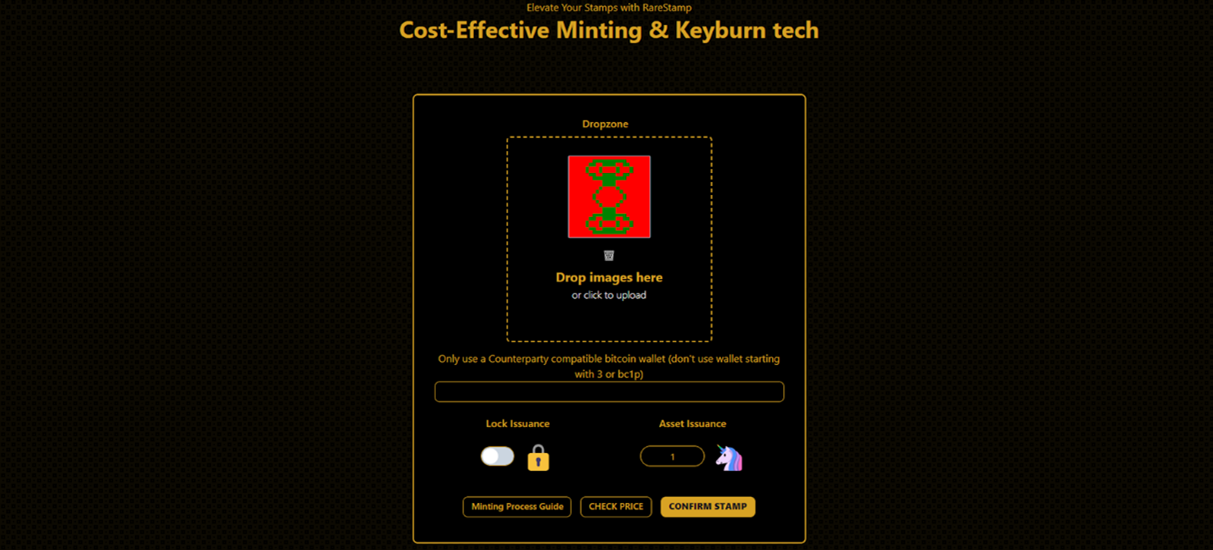
Making Stamps seems to be much more expensive than making Inscriptions, and we will see if Stamps can oust the more famous Ordinals from the top of the Bitcoin NFT game. To view existing Stamps, check out this interesting catalog.
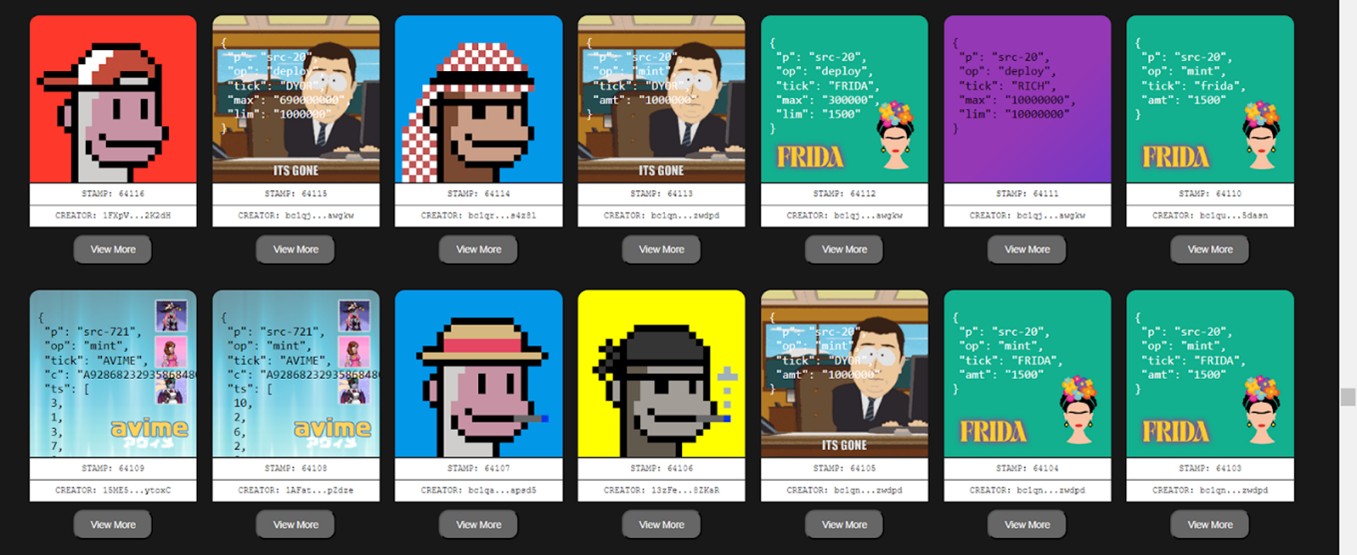
Just as with the Ordinals, it is also possible to find strange things on the Stamps website, and also play (good luck with this one and this).
Last Word on Ordinals and Inscriptions
To interact with Ordinals, you will need an Ordinal-friendly wallet, such as:
- unisat_wallet
- xverseApp
- hirowallet
What about where to find, buy, and sell Ordinals? There are many marketplaces, including:
- MagicEden
- unisat_wallet
- ordinalswallet
There is also a live Twitter show — The Ordinal Show — hosted by trevor.btc, Jan, and Leonidas.og for news, new projects and insights on the topic.
BRC-20: The Big Trend
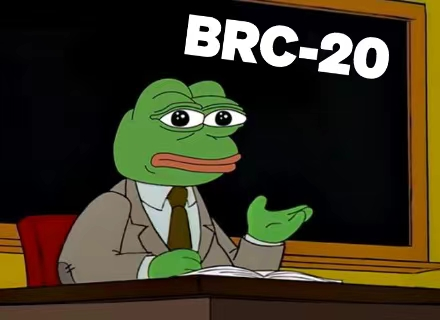
Just as Inscriptions were enjoying their moment of glory, a new trend has come to the fore. On March 8, 2023 Domodata implemented what he calls an experiment: BRC-20, which in a very short time has reached an incredible market cap.
How BRC-20 Works
I want to thank my friend Crypto Ita for the detailed explanation and his exceptionally clear content, even on technical issues. The explanation below is just a bit technical, but important, because it reveals a point of failure of this protocol.
While Ordinals have brought non-fungibility (the NF in NFT) to the Bitcoin blockchain by creating immutable digital artifacts, the BRC-20 standard gives fungibility to Ordinals and Inscriptions in the form of token transfers.
This fungibility is made possible through the use of JSON, an open standard format for file and data exchange. With BRC-20, a script file is stored on the Bitcoin blockchain that assigns tokens to satoshi, which allows tokens to be transferred to other users. This script can be used to deploy, mint, and transfer tokens.
BRC-20 tokens might bring to mind their better-known predecessor, the ERC-20, which is the standard token format on Ethereum. This is just a play on words, for in reality, BRC-20 differs significantly from ERC-20. While ERC-20 operate on smart contracts, the BRC-20 do not need them as they can be distributed by passing satoshi from one address to another.
A Double-Spending Danger
The most important difference is the fact that the ERC-20 standard is governed by Ethereum’s own consensus model, whereas BRC-20 is not bound by the rules of the Bitcoin network.
BRC-20 represents a protocol that substantially overlaps with the Bitcoin network but does not follow the same rules imposed by the latter in terms of consensus.
The Bitcoin protocol only sees the transfer of satoshi and not the inscription on them, so the transfer of a satoshi with “1000 ORDI” inscribed on it will always be deemed valid on the Bitcoin network. This is the case even if the person who transferred the 1000 ORDI had not minted them first (and therefore did not have the availability).
It is up to users using the BRC-20 protocol to recognize the invalidity of that “transfer” Inscription and disregard it. For the Bitcoin blockchain, all transactions are valid. This leaves a real risk of double spending. There are, of course, attempts to remedy this problem.
How Can You Mint Your BRC-20 Tokens?
There are three phases that basically correspond to the use of three functions:
- the “deploy phase” that allows the token to be created
- the “mint phase” that allows the amount of tokens to be generated
- the “transfer phase” that allows the tokens to be transferred.
The Deploy Phase
The “deploy phase” consists of the creation of an Inscription that contains data that is saved in the Witness Data Section of a Taproot transaction. Even more specifically, it involves the inscription of text on a satoshi using the JSON format. The latter is based on a set of “keys” and “values” that indicate the essential characteristics for creating the token. Main keys include:
- p= the protocol (e.g., the BRC-20 protocol)
- op= the type of operation (e.g., the deploy operation)
- tick= the ticker (e.g., the 4-letter code that distinguishes the token)
- max= the maximum number of mintable tokens (e.g., 21,000,000)
- lim= the mint limit for each minting inscription (e.g., 1000)
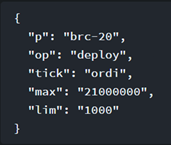
The Mint Phase
The “mint phase” consists of the creation of an Inscription, the content of which is always represented by text respecting the JSON format. There are “keys” and “values” in this case as well but the value associated with the op key changes, which in this case will be mint and not deploy, and there is a new AMT key indicating the amount of mintable tokens on a single Inscription (the latter must be a value between zero and what is provided by the limit value in the deploy inscription).
It is important to remember that anyone can create a mint function, even those who did not generate tokens with the deploy function.
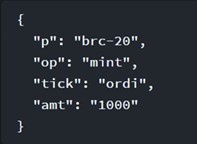
The Transfer Phase
The “transfer phase” is divided into two micro-phases. In the first microphase an Inscription is created, consisting of text according to the JSON format. Again, the value associated with the op key changes, which will be “transfer” while the value associated with the AMT key will be between zero and the limit set in the mint function.
Note that the first owner of this Inscription must be the same owner who received the tokens minted in the previous mint phase. In the second microphase there is the transfer of the previous Inscription.
For a more practical description, you can read this guide by Ordinal Labs.

BRC-20 Collections
The first BRC-20 token ever created was the ORDI, made to demonstrate the potential of the new standard. Distribution of ORDI was limited to 1,000 tokens per minter, with a total supply limit of 21 million tokens. ORDI is also the most well-capitalized BRC-20 token, exponentially higher than the number two token by market cap, $B20.
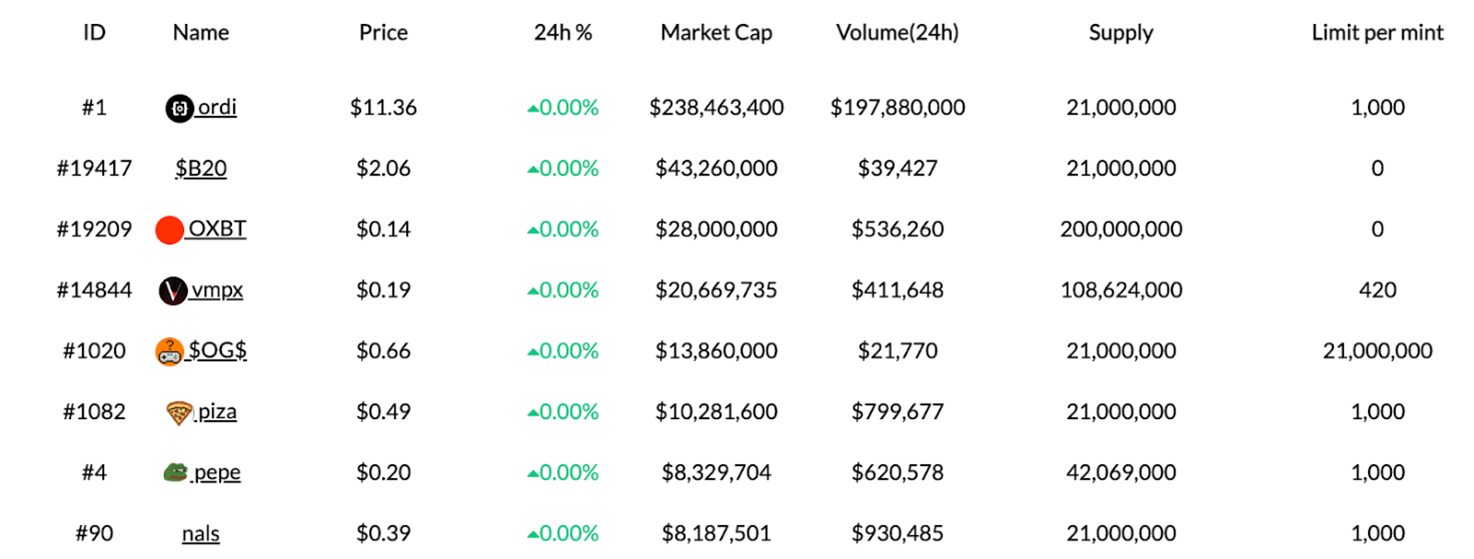
Finally, check out the Unisat.io portal, which enables an experience very similar to that of other marketplaces, with a sort of �?order book’ format to view available BRC-20 tokens.
And obviously there is the stablecoin. On May 25, 2023 the Bitcoin network’s first-ever BRC-20 stablecoin was announced: Stably USD.
For lovers of data and analysis of BRC-20 tokens, check out:
- BRC-20 (BRC-20 Ordinals)
You will find info about total BRC-20 transactions, total fee paid for BRC-20 transactions, % bitcoin transactions, and % fee, n. of BRC-20 transactions deployed, minted, and transferred. - BRC-20 Tokens and Addresses
You will find info about the top 14 BRC-20 tokens by market cap.
The Antagonist of BRC-20: ORC-20
As was the case with Stamps versus Ordinals, other experiments have sprung up alongside BRC-20 with the aim of solving the alleged shortcomings of these tokens.
Among these experiments is ORC-20, another open standard protocol for Ordinal tokens on Bitcoin that is designed to be backwards compatible with BRC-20 tokens.
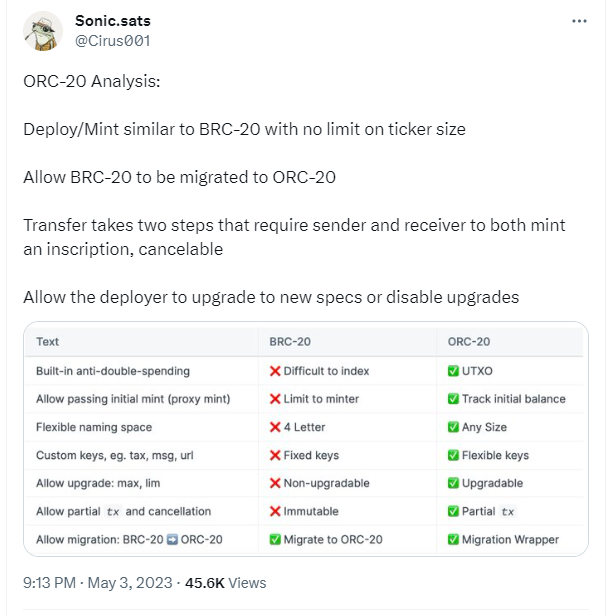
ORC-20 was primarily designed to eliminate the possibility of double spending, the major problem with BRC-20.
With BRC-20, the number of mintable tokens could not be changed after deployment. The creators of the ORC-20 standard claim to have overcome this limitation by including an update that allows the supply and the minting cap of current BRC-20 tokens to be updated.
In addition, the denomination of BRC-20 tokens, the ticker, is limited to 4 digits. ORC-20 tickers have no size constraints and the data contained in the Inscriptions are not case sensitive. But the most important change is the fact that, according to the creators of ORC-20, the transfer and accounting of BRC-20s are based on centralized indexers, and this could create a double spending problem.
In contrast, the ORC-20 model is based on UTXO which avoids this problem. This is a comparison of the two protocols:
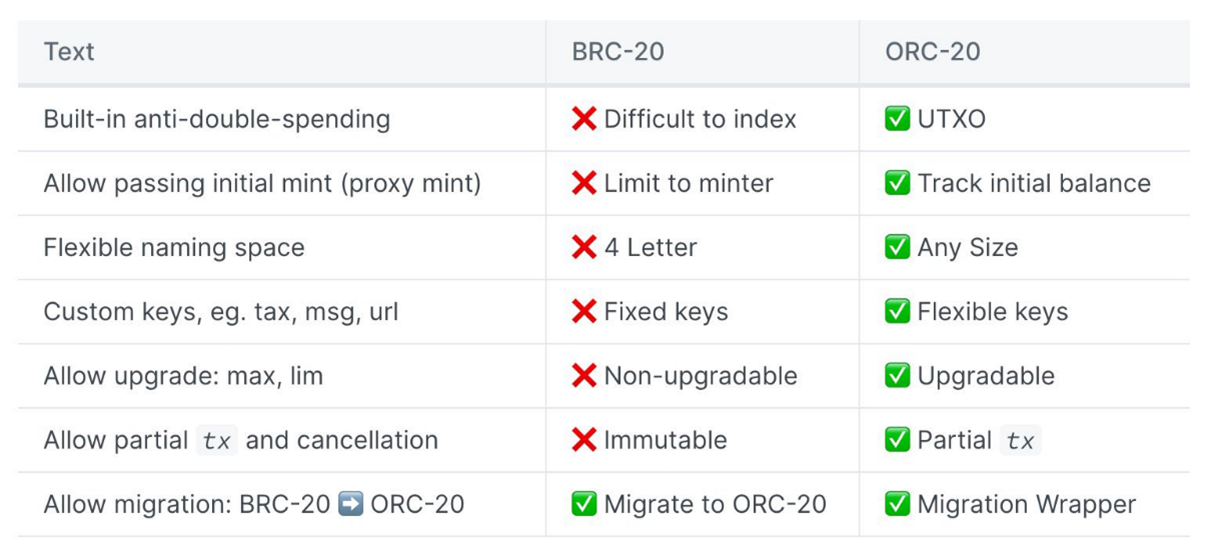
The creators of ORC-20 have proposed migrating BRC-20 tokens to ORC-20 tokens (which only the BRC-20 token distributor can do by creating an Ordinal distribution event). As part of the ORC-20 documentation there is a section for the community projects.
In the Dune dashboard pictured below, you will find info and stats on Ordinals, BRC-20s, ORC-20s, and SRC-20s:
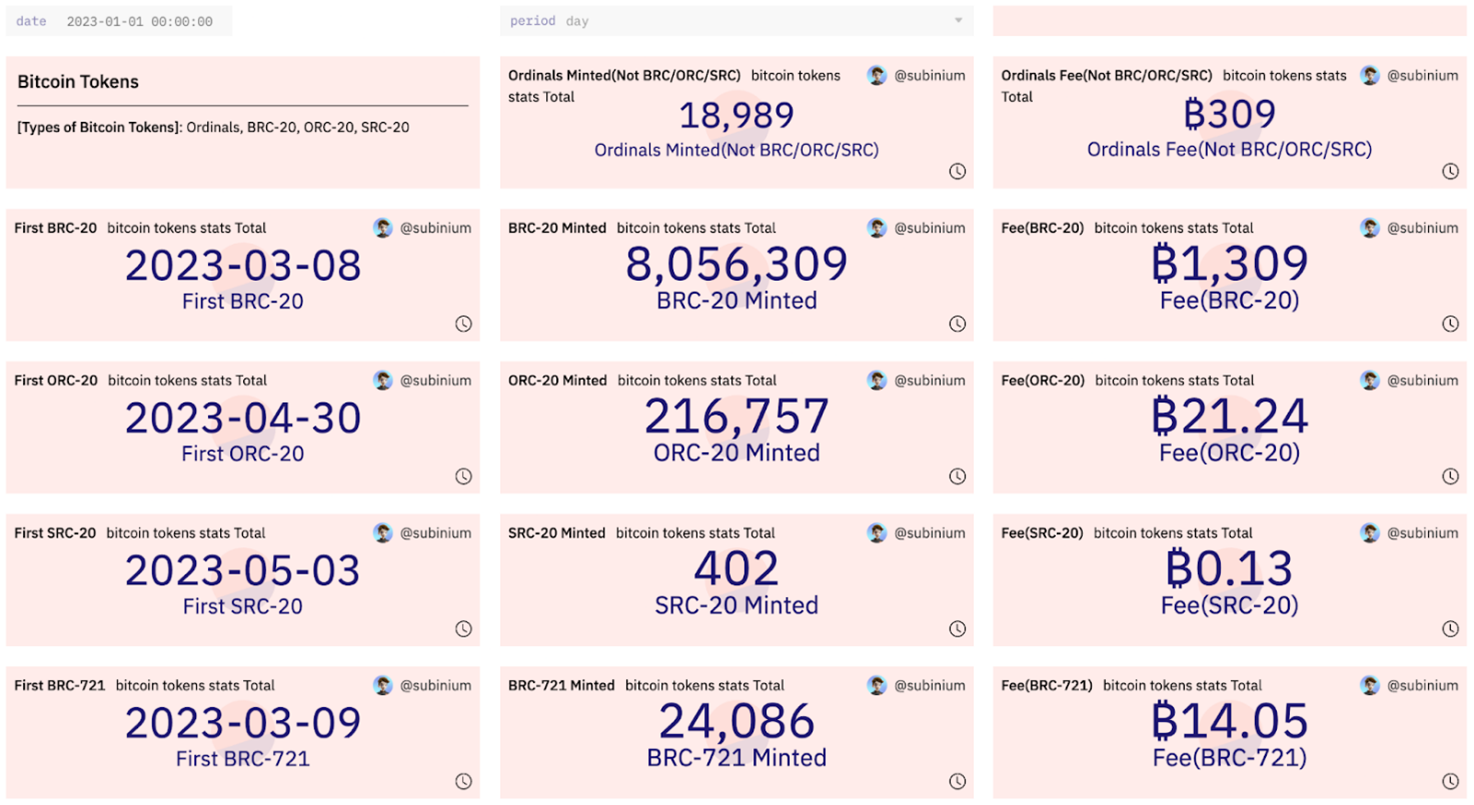
Other Interesting Stuff…
Beyond Ordinals and Inscriptions, BRC-20, ORC-20, and SRC-20, did you know about Sats Names, BRC-21, BRC-30, BRC-42, BRC-721, BRC-721E, DRC-20, Wrapped Ordinals, and DeFi on Bitcoin?!
Let’s do a quick roundup.
Sats Names: Among the trends, this is among the most important. Sats Names is a standard for writing names to Ordinals. Its goal is to build a name ecosystem for Bitcoin, developed entirely on Bitcoin. Proponents believe that this system has various advantages and adds value to many existing products and ecosystems. For example, it will be possible to use .sats in Nostr as your own Lightning address, as your public Bitcoin address, and as a login for dApps.
BRC-21: This is a proposal for a standard to mint and redeem BRC-20 tokens to/from Bitcoin that have been created on other “source” chains, such as Ethereum, Cosmos, Polkadot, or Interlay, all without reliance on a third party. Proponents believe that the main use case for this standard is the distribution of decentralized stablecoins on the Lightning Network or similar payment protocols.
BRC-30: BRC-30 adopts the design principles of BRC-20, and introduces equity operation functions such as deposit, casting, and withdrawal. The proposal aims to introduce a staking mechanism for BRC-20 tokens and bitcoins on the Bitcoin network. With the introduction of BRC-30, users can stake their own BRC-20 tokens and bitcoins and receive corresponding BRC-30 tokens in return. In this way, BRC-20 token holders can put their digital assets to work and earn passive income without having to sell those tokens.
BRC-42: This is a proposal to extend the BRC-20 standard to allow the bridging of BRC-20 tokens to chains with smart contract support, such as Ethereum, Interlay, Solana, and Polkadot, all without reliance on a third party. Proponents believe that the main use case for BRC-20 tokens is to unlock access to decentralized financial protocols.
Generative BRC-721: Generative BRC-721 is a new standard created by Italian dev 0xJerry543 that lets you create generative Ordinals collections that are non-fungible. The goal is optimization of block space usage (50% to 90%). This optimization benefits creators trying to enter the space by lowering the fees for deploying their collections.
BRC-721E: A simple protocol which allows ERC-721s, the Ethereum (and EVM) standard for many NFTs, to migrate to Bitcoin on their own schedule, without inscribing an entire collection beforehand. BRC-721E should enable permissionless bridging from Ethereum to Bitcoin, allow for NFTs to be instantly listed on marketplaces once inscribed, and be cost efficient for large collections
DRC-20: Dogecoin and Bitcoin? Is this just a joke? We shall see…
And while someone is talking about Wrapped Ordinals, here comes DeFi on the Bitcoin network.
Finally, there are several projects emerging based on Ordinals and their use, including:
- Bitcoin Frontier Fund is trying to create a growing community of founders and investors.
- New Bitcoin City has discovered a method to make bitcoin as versatile as possible and expand its use cases.
Bonus: How to Navigate This Crazy World
You may find interesting news from these Twitter accounts:
trevor.btc | Leonidas.og | Jan | Mark Jeffrey | Udi Wertheimer | BitGod and other interesting profiles listed here.
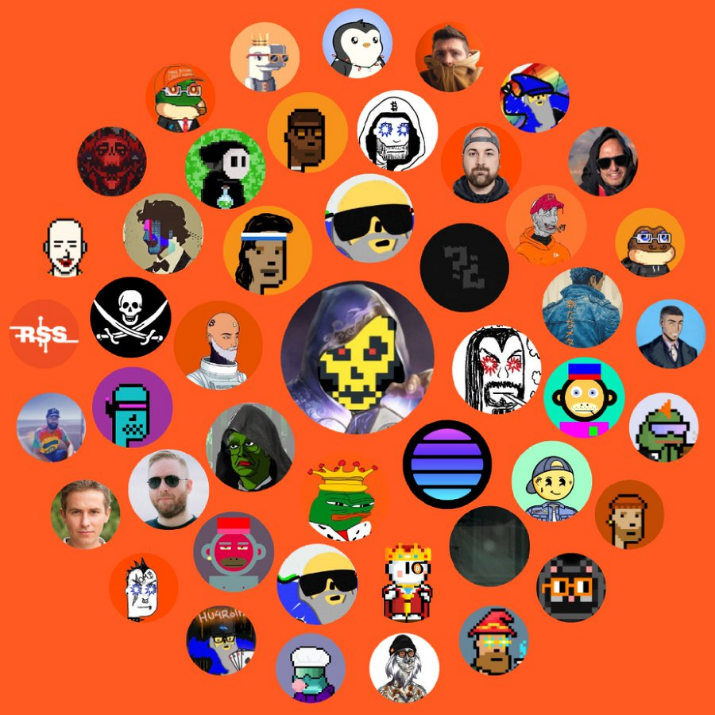
Out of the Ordinary
In summary, we are facing a Bitcoin world in turmoil, as exciting as any early experiment and full of pitfalls, so one must always be cautious and do their own research.
But all new things should always be welcomed because, at best, they give rise to great revolutions, at worst, they lead to important reflections.
Let’s not forget that all this stuff here has been blessed by Michael …
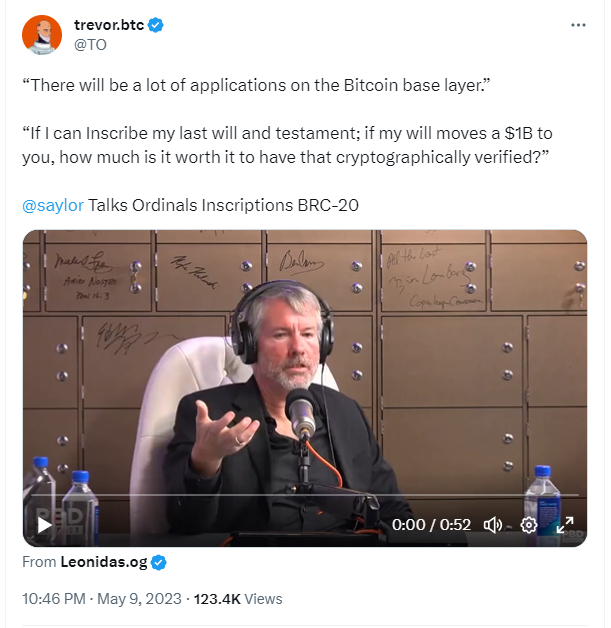
And while you’re at it, take a look at the largest Bitcoin address: 34xp4vRoCGJym3xR7yCVPFHoCNxv4Twseo, which is the Binance cold storage wallet controlled by @cz_binance. Check out those Ordinals:
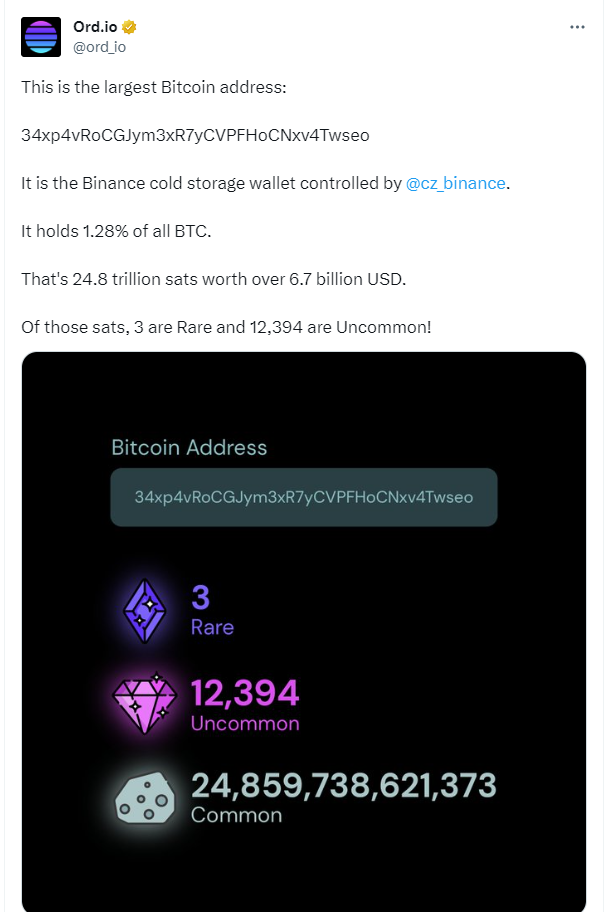
Author Bio
Tigi76 is an attorney qualified in Italy — In house Lawyer (Commercial, Contract Law, M&A) — Blockchain, Web3 and Crypto Enthusiast — BanklessDAO Contributor — 333.builders Contributor — Member of the Blockchain Association Italy — Member of Blockchain Education Network Italia.
Editor Bios
Hiro Kennelly is a writer, editor, and coordinator at BanklessDAO, an Associate at Bankless Consulting, and is helping to build a grants-focused organization at DAOpunks.
Trewkat is a writer and editor at BanklessDAO. She’s interested in learning as much as possible about crypto and NFTs, with a particular focus on how best to communicate this knowledge to others.
Designer Bio
Tonytad is a graphic designer who has worked locally and internationally with organisations and firms on over 200 projects, which includes branding, logo, flyers, cards, and covers.
BanklessDAO is an education and media engine dedicated to helping individuals achieve financial independence.
This post does not contain financial advice, only educational information. By reading this article, you agree and affirm the above, as well as that you are not being solicited to make a financial decision, and that you in no way are receiving any fiduciary projection, promise, or tacit inference of your ability to achieve financial gains.
Bankless Publishing is always accepting submissions for publication. We’d love to read your work, so please submit your article here!
More Like This
Invest in BTC and ETH and Forget the Rest by Frank America
12 Crypto Predictions For 2023 by KAF
Crypto Twitter Talks 2023 Trends by Tigi76






